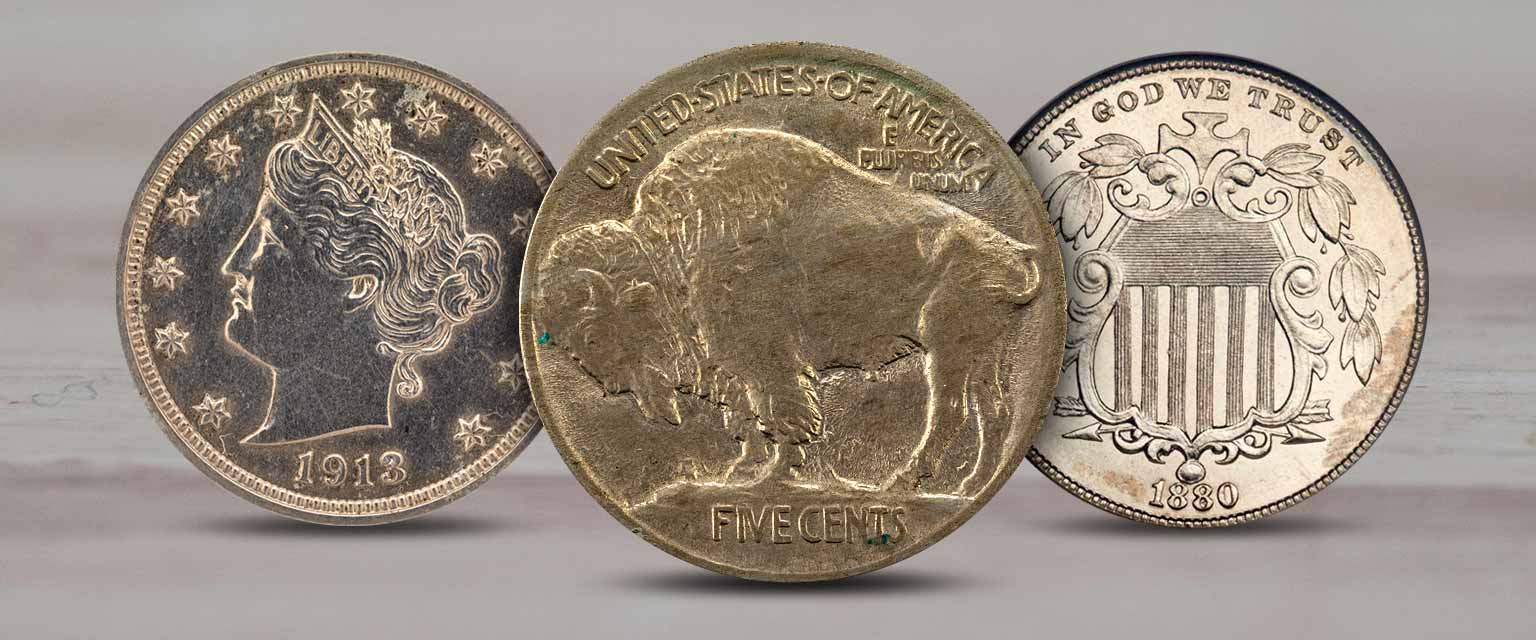We’re back with part ten of our educational series exploring America’s classic coin denominations. This time, we’ll delve into the history and highlights of U.S. 5-cent nickels spanning over 150 years since their 1865 authorized inception. From Shield nickels to silver wartime issues and modern Jeffersons, let’s uncover the intrigue around this coin.
The Origins of Nickels – Shield Nickels 1866-1883
Through the Act of May 16, 1866, 3-cent pieces were authorized with the composition of nickel. 1866 is the first year and featured 13 rays and 13 stars to represent the 13 original colonies. In 1867, there were 2 varieties. The first type featured rays; the second type had no rays (1867-1883).
James B. Longacre’s Shield nickel design ushered in the new 5-cent piece approved in 1866 as a base-metal alternative to silver half dimes. The obverse featured a shield with a striped banner reading “In God We Trust” – one of the earliest uses of the enduring national motto on U.S. coinage. The digit “5” appeared inside the shield with 13 stars ringing the border. The reverse displayed the Roman numeral date within a graceful wreath surrounding the denomination “CENTS.” While an effective motif, the blank fields proved prone to quick wearing in circulation. Shield nickels spanned the years 1866 through 1883 before being replaced by Charles Barber’s new Liberty Head design. 1880 is the rarest of all Shield Nickels, with only 16,000 minted. They range in price from $100 to $25,000. Attractively toned Shield nickels are popular among type collectors.
The Famous 1913 Liberty Head Nickel Rarity
While most Shield and Liberty Head nickels are readily obtainable for collectors today, one legendary key date remains the 1913 Liberty Head issue. No 1913 nickels were officially struck for circulation, yet a handful of examples inexplicably surfaced over the years bearing that enigmatic year.
These coins rank among the most famous U.S. numismatic rarities, with the few authenticated specimens trading hands for as much as $4 million or more given the mystique. The origin of the 1913 nickels remains shrouded in mystery, adding to their allure.
A North Carolina collector, George O. Walton, purchased one of the coins in the mid-1940s for a reported $3,750. The coin was with him when he was killed in a car crash on March 9, 1962, and it was found among hundreds of coins scattered at the crash site. The 1913 Liberty Head nickel is one of only five known to exist and will likely fetch millions at auction.
Buffalo Nickels – An Iconic Design of the West
James Earle Fraser’s iconic Buffalo Nickel replaced the staid Liberty Head design starting in 1913, bringing a uniquely American motif to the 5-cent series. The obverse depicted a Native American portrait modeled after Chief Iron Tail of the Lakota tribe.
The reverse featured a charging American bison along with the inscriptions “BUFFALO NICKEL” and Fraser’s raised initial “F” placed below. The classic Buffalo nickel design ran through 1938, spanning over a decade of circulation and remaining widely collected today. Key dates include the low-mintage 1926-D, 1927-D, and 1937-D issues. Be sure to look for that 1937 D 3-Legged Buffalo worth from $200 to over $4000.
Modern Jefferson Nickels
Thomas Jefferson’s portrait returned to nickel coinage in 1938 with Felix Schlag’s new design featuring the Declaration of Independence author and early silver Jefferson pattern coins on the obverse. Monticello graces the reverse in dual tribute to Jefferson. Wartime issues saw silver compositions from 1942-1945 before transitioning back to nickel-copper Look out for modern nickels, specifically the 1939 Double Monticello Reverse or Silver War Nickels from 1942-1945. The 1950 D is a common one missed.
Jefferson nickels remain in production today with occasional updates like the 2004-2005 Westward Journey series and modern Lewis & Clark commemoratives. Specimen set, proof, and silver issues add diversity for modern collectors.
We hope you’ve enjoyed this overview of classic and modern nickels. Please stay tuned for future installments of our numismatics journey! In the meantime, visit the CV Coins and Collectables website to explore nickels and other great U.S. coins. Our experienced staff looks forward to assisting across all budget ranges.
Check out the other parts in this series:
- Part 1: An Intro to Collecting Coins and Other Currency
- Part 2: Half Cents and Large Cents
- Part 3: Proof and Mint Sets & Commemoratives
- Part 4: Indian and Lincoln Cents
- Part 5: The Forgotten Coins: A Look at Two Cent and Three Cent Pieces
- Part 6: Silver Eagles and Commemoratives
- Part 7: Dimes and 20-Cent Pieces
- Part 8: Quarters
- Part 9: Half-Dollars
- Part 10: Nickels

